Things Can Change Quickly These Days
What a difference a week can make in this game, right? Last week at this time, the market was reacting in a rather hysterical fashion, of course, to news that the President was planning to use punitive tariffs in his quest to strike a deal on immigration with Mexico.
At the beginning of last week, traders were also fretting that the Fed would turn a blind eye to the mounting impact of tariffs and the now obvious economic slowdown happening around the globe. The fear was the Fed would wind up making a policy mistake, which could lead to a recession here at home.
And last week, stocks were breaking down below important support and the media's favorite technical indicator - the 200-day moving average. The bearishly inclined opined that this was a harbinger of bad things to come and that a full-fledged retest of the December lows was on tap.
Things Were Getting Ugly
The price action was clearly negative. Sentiment had become dour. Technical indicators were breaking. Market models were flashing red. And the words, "here we go again," summarized the outlook of several market analysts I chatted with.
However, a funny thing happened on the way to the market debacle, things changed - quickly. Headlines began crossing that countered the big fears and before you could check the spelling of the word tariffs, stocks turned around. Shorts covered. Algos went the other way. And in the end, the S&P had one of the best weeks of the year.
Such is the way the game is played in a news-driven market environment. Good times.
The Mood Improved
First there was word that Mexico had scurried up to Washington to try and satisfy the administration that it was doing enough to avoid getting slapped with punitive tariffs. And after a couple days of chatting, bam - a deal was done. Granted, it was basically the same deal that we had already agreed to. But the bottom line is President could put "W" on the board on this one. Problem solved.
The Fed "Gets It"
But the big news and the big driver of the stock market's joyride to the upside was the latest pivot by the Fed. Just when things were starting to look grim, Mr. Powell and company rode to the rescue by saying they were thinking about cutting rates.
No, the Fed Chairman did not say the Fed was ready to cut rates. Well, not in so many words. But those who spend their days analyzing the Federal Reserve board felt that Mr. Powell and several of his cohorts had effectively put what is referred to as "the Fed put" back on the table.
For example, St. Louis Fed President James Bullard kicked things off on Monday by saying that a rate cut could be "warranted soon." While this didn't necessarily turn the market around, this message did seem to set the stage for Mr. Powell.
According to Fed watchers, Powell didn't disappoint. Sarah Bloom Raskin, who sat on the Fed board from 2010 to 2014, suggested on CNBC Wednesday that the U.S. Federal Reserve has sent a "very strong signal" that it's ready to consider cutting interest rates.
Specifically, Chairman Jerome Powell said in a speech that the Fed "will act as appropriate to sustain the expansion."
To someone who has been in the room, those words meant that the Fed was paying attention and wouldn't hesitate to act in a dovish fashion. Raskin said on CNBC, "I think Chairman Powell has given a message to markets that's indicating that a rate cut is coming. This is, in essence, a very strong signal that the FOMC is actually ready to talk about cutting rates."
Then when you mix in the comments made recently by other Fed officials, the message becomes even more clear.
For example, Mary Daly, the President of Federal Reserve Bank of San Francisco said early last week that uncertainty over trade and tariffs could cause business to take a wait and see approach, which, could in turn, slow the economy further.
"What really keeps me up at night is the data and the mood getting out of sync and, eventually, the possibility that the mood becomes the self-fulfilling prophecy of the data," Daly said at a conference on Monday.
Daly suggested that if "people are really uncertain, they fear a recession, or they fear a downturn and this gets incorporated into their thinking and then they spend or invest less." And extrapolating, "less spending and investment creates a slowdown that we wouldn’t have otherwise had," Daly said.
Mohamed El-Erian, Allianz chief economic advisor, also offered thoughts that were worth noting. El-Erian said on CNBC last week that market volatility is higher because the market is looking at a period of unusual uncertainty.
El-Erian said the "economic outlook is more vulnerable... I think it means market technicals are more fragile, and it involves a higher risk of a spill back from disrupted markets to the economy. It's a different outlook than it was last week."
So, the good news is that it seems Mr. Powell "gets it" here. Powell is effectively saying that the Fed understands that uncertainty regarding trade and the administration's use of tariffs as a political weapon could easily wind up slowing the economy. And since the President has held firm to his desire to negotiate on many fronts, the reality is that this game isn't likely to end anytime soon. As such, it appears that Jerome Powell is reassuring markets that the Fed will be there if things go awry.
To which, the stock market basically said, "thank you."
So, on this fine Monday morning we can eliminate the fear over Mexico and the fear that the Fed is going to make a policy mistake. These are two pretty big check marks. Which would appear to be why the S&P 500 is back to within a stone's throw of all-time highs.
Now if we could just get that China deal done...
Disclosures
At the time of publication, Mr. Moenning held long positions in the following securities mentioned: None - Note that positions may change at any time.
Weekly Market Model Review
Now let's turn to the weekly review of my favorite indicators and market models...
The State of My Favorite Big-Picture Market Models
The Primary Cycle board improved a bit this week as both our Risk/Reward and Desert Island models upticked. The Risk/Reward Model moved back into positive territory and to a buy signal while my "Desert Island" model moved up into the neutral zone. As such, I believe the odds continue to favor the bulls from a big-picture standpoint.
This week's mean percentage score of my 6 favorite models improved to62.9% from 60% last week (Prior readings: 60%, 72.5%, 81.1%, 83.9%, 84.7%, 74.6%) while the median also upticked to 68.8% versus 62.5% last week (Prior readings: 62.5%, 80.0% 82.5%, 86.7%, 86.7%, 81.8%, 65.9%).
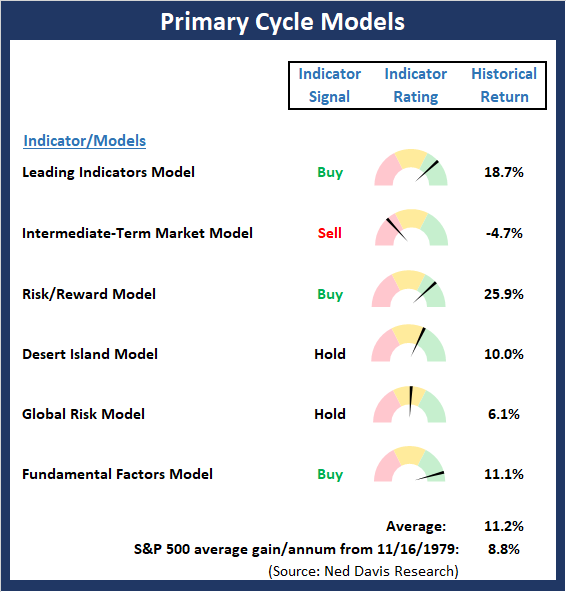
View My Favorite Market Models Online
The State of the Fundamental Backdrop
I am pleased to report that there was some slight underlying improvements to the Fundamentals board this week. For example, the Monetary Composite, which is a combination of 3 models, upticked in response to the decline in rates. In addition, the Economic Composite, which also is composed of 3 independent models, also saw some improvement. So, as I've been saying, the backdrop continues to support the continuation of the bull market once the current corrective phase/news environment plays out.
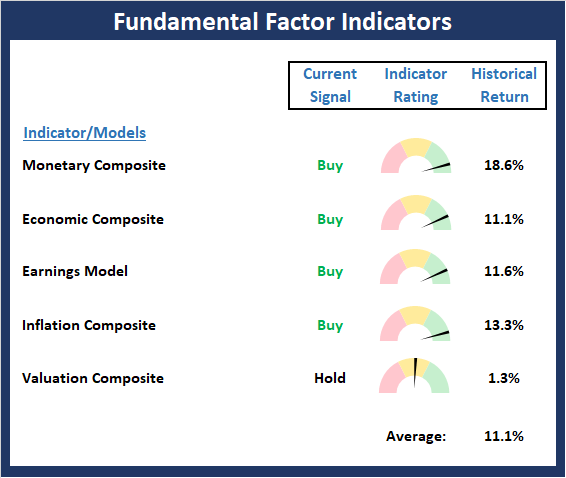
View Fundamental Indicator Board Online
The State of the Trend
With the news on the trade front improving and the Fed appearing to pivot once again in a dovish direction, it was no surprise that traders went back to a risk-on mode last week. While I can argue that the market remains trapped in a trading range and driven by news, the Trend board perked up a fair amount last week. The key is that while stocks started the week by appearing to break important support zones, they ended the week in fine fashion. In short, a technical breakdown was quickly reversed and a crisis was avoided.
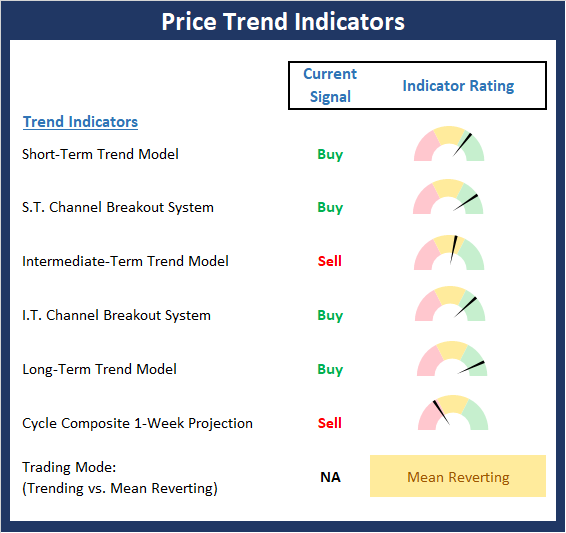
View Trend Indicator Board Online
The State of Internal Momentum
While the Momentum Board is a far cry from positive, it was encouraging to see a fair amount of improvement in a short period of time. The Short-Term Trend & Breadth Confirm model improved, as did the Intermediate-Term Breadth Model, the Long-Term Volume indicator, and both the Intermediate-Term Volume and Breadth Thrust indicators. As such, I will suggest that the bulls have a shot at regaining possession in the very near future.
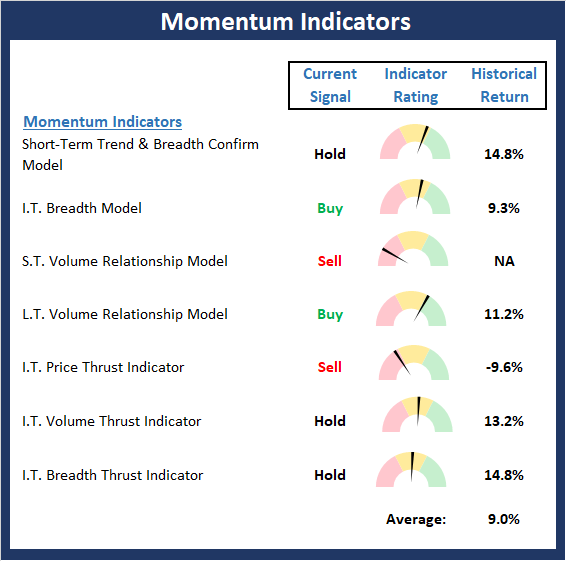
View Momentum Indicator Board Online
The State of the "Trade"
After doing a fine job, in my opinion, of warning that the table was set for a rebound, the Early Warning board has now moved to a more neutral state. With all three of our Sentiment Models still solidly positive, I believe this is a clear message that market players had become too negative, which, again, sets the stage for a bounce. It is now up to the bulls to take the ball and run with it.
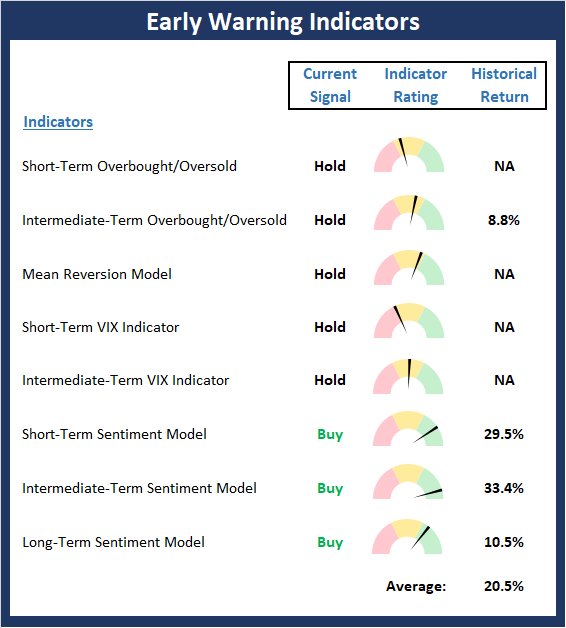
View Early Warning Indicator Board Online
Thought For The Day:
Logic will get you from A to B. Imagination will take you everywhere. - Albert Einstein
Wishing you green screens and all the best for a great day,

David D. Moenning
Founder, Chief Investment Officer
Heritage Capital Research
HCR Focuses on a Risk-Managed Approach to Investing
What Risk Management Can and Cannot Do
Leading Indicators Model: A group of indicators that have historically shown tendencies to lead the market at major turning points.
Intermediate-Term Market Model: A composite model (model of models) focused on trend and momentum indicators which has been designed to provide identify intermediate-term trading opportunities.
Risk/Reward Model: A model-of-models intended to provide an overall view of the state of the risk/reward environment. The model includes tape, monetary, and sentiment indicators as well as 7 big-picture market model readings.
Desert Island Model: If I was stranded on a desert island with access to only one market model to manage money with, this would be the model. The model is a comprehensive model-of-models comprised of trend, momentum, mean reversion, economic, monetary, sentiment, and factor-based indicators/models.
External Factors Model: A model-of-models designed to provide a reading on the "macro state" of the market environment. The model is comprised of indicators/models in the areas of various index yields, industrial production, investors sentiment, and historic volatility.
Short-Term Trend-and-Breadth Signal Explained: History shows the most reliable market moves tend to occur when the breadth indices are in gear with the major market averages. When the breadth measures diverge, investors should take note that a trend reversal may be at hand. This indicator incorporates NDR's All-Cap Dollar Weighted Equity Series and A/D Line. From 1998, when the A/D line is above its 5-day smoothing and the All-Cap Equal Weighted Equity Series is above its 25-day smoothing, the equity index has gained at a rate of +32.5% per year. When one of the indicators is above its smoothing, the equity index has gained at a rate of +13.3% per year. And when both are below, the equity index has lost +23.6% per year.
Channel Breakout System Explained: The short-term and intermediate-term Channel Breakout Systems are modified versions of the Donchian Channel indicator. According to Wikipedia, "The Donchian channel is an indicator used in market trading developed by Richard Donchian. It is formed by taking the highest high and the lowest low of the last n periods. The area between the high and the low is the channel for the period chosen."
Intermediate-Term Trend-and-Breadth Signal Explained: This indicator incorporates NDR's All-Cap Dollar Weighted Equity Series and A/D Line. From 1998, when the A/D line is above its 45-day smoothing and the All-Cap Equal Weighted Equity Series is above its 45-day smoothing, the equity index has gained at a rate of +17.6% per year. When one of the indicators is above its smoothing, the equity index has gained at a rate of +6.5% per year. And when both are below, the equity index has lost -1.3% per year.
Cycle Composite Projections: The cycle composite combines the 1-year Seasonal, 4-year Presidential, and 10-year Decennial cycles. The indicator reading shown uses the cycle projection for the upcoming week.
Trading Mode Indicator: This indicator attempts to identify whether the current trading environment is "trending" or "mean reverting." The indicator takes the composite reading of the Efficiency Ratio, the Average Correlation Coefficient, and Trend Strength models.
Volume Relationship Models: These models review the relationship between "supply" and "demand" volume over the short- and intermediate-term time frames.
Price Thrust Model Explained: This indicator measures the 3-day rate of change of the Value Line Composite relative to the standard deviation of the 30-day average. When the Value Line's 3-day rate of change have moved above 0.5 standard deviation of the 30-day average ROC, a "thrust" occurs and since 2000, the Value Line Composite has gained ground at a rate of +20.6% per year. When the indicator is below 0.5 standard deviation of the 30-day, the Value Line has lost ground at a rate of -10.0% per year. And when neutral, the Value Line has gained at a rate of +5.9% per year.
Volume Thrust Model Explained: This indicator uses NASDAQ volume data to indicate bullish and bearish conditions for the NASDAQ Composite Index. The indicator plots the ratio of the 10-day total of NASDAQ daily advancing volume (i.e., the total volume traded in stocks which rose in price each day) to the 10-day total of daily declining volume (volume traded in stocks which fell each day). This ratio indicates when advancing stocks are attracting the majority of the volume (readings above 1.0) and when declining stocks are seeing the heaviest trading (readings below 1.0). This indicator thus supports the case that a rising market supported by heavier volume in the advancing issues tends to be the most bullish condition, while a declining market with downside volume dominating confirms bearish conditions. When in a positive mode, the NASDAQ Composite has gained at a rate of +38.3% per year, When neutral, the NASDAQ has gained at a rate of +13.3% per year. And when negative, the NASDAQ has lost at a rate of -14.279% per year.
Breadth Thrust Model Explained: This indicator uses the number of NASDAQ-listed stocks advancing and declining to indicate bullish or bearish breadth conditions for the NASDAQ Composite. The indicator plots the ratio of the 10-day total of the number of stocks rising on the NASDAQ each day to the 10-day total of the number of stocks declining each day. Using 10-day totals smooths the random daily fluctuations and gives indications on an intermediate-term basis. As expected, the NASDAQ Composite performs much better when the 10-day A/D ratio is high (strong breadth) and worse when the indicator is in its lower mode (weak breadth). The most bullish conditions for the NASDAQ when the 10-day A/D indicator is not only high, but has recently posted an extreme high reading and thus indicated a thrust of upside momentum. Bearish conditions are confirmed when the indicator is low and has recently signaled a downside breadth thrust. In positive mode, the NASDAQ has gained at a rate of +22.1% per year since 1981. In a neutral mode, the NASDAQ has gained at a rate of +14.5% per year. And when in a negative mode, the NASDAQ has lost at a rate of -6.4% per year.
Short-Term Overbought/sold Indicator: This indicator is the current reading of the 14,1,3 stochastic oscillator. When the oscillator is above 80 and the %K is above the %D, the indicator gives an overbought reading. Conversely, when the oscillator is below 20 and %K is below its %D, the indicator is oversold.
Intermediate-Term Overbought/sold Indicator: This indicator is a 40-day RSI reading. When above 57.5, the indicator is considered overbought and wnen below 45 it is oversold.
Mean Reversion Model: This is a diffusion model consisting of five indicators that can produce buy and sell signals based on overbought/sold conditions.
VIX Indicator: This indicators looks at the current reading of the VIX relative to standard deviation bands. When the indicator reaches an extreme reading in either direction, it is an indication that a market trend could reverse in the near-term.
Short-Term Sentiment Indicator: This is a model-of-models composed of 18 independent sentiment indicators designed to indicate when market sentiment has reached an extreme from a short-term perspective. Historical analysis indicates that the stock market's best gains come after an environment has become extremely negative from a sentiment standpoint. Conversely, when sentiment becomes extremely positive, market returns have been subpar.
Intermediate-Term Sentiment Indicator: This is a model-of-models composed of 7 independent sentiment indicators designed to indicate when market sentiment has reached an extreme from a intrmediate-term perspective. Historical analysis indicates that the stock market's best gains come after an environment has become extremely negative from a sentiment standpoint. Conversely, when sentiment becomes extremely positive, market returns have been subpar.
Long-Term Sentiment Indicator: This is a model-of-models composed of 6 independent sentiment indicators designed to indicate when market sentiment has reached an extreme from a long-term perspective. Historical analysis indicates that the stock market's best gains come after an environment has become extremely negative from a sentiment standpoint. Conversely, when sentiment becomes extremely positive, market returns have been subpar.
Absolute Monetary Model Explained: The popular cliche, "Don't fight the Fed" is really a testament to the profound impact that interest rates and Fed policy have on the market. It is a proven fact that monetary conditions are one of the most powerful influences on the direction of stock prices. The Absolute Monetary Model looks at the current level of interest rates relative to historical levels and Fed policy.
Relative Monetary Model Explained: The "relative" monetary model looks at monetary indicators relative to recent levels as well as rates of change and Fed Policy.
Economic Model Explained: During the middle of bull and bear markets, understanding the overall health of the economy and how it impacts the stock market is one of the few truly logical aspects of the stock market. When our Economic model sports a "positive" reading, history (beginning in 1965) shows that stocks enjoy returns in excess of 21% per year. Yet, when the model's reading falls into the "negative" zone, the S&P has lost nearly -25% per year. However, it is vital to understand that there are times when good economic news is actually bad for stocks and vice versa. Thus, the Economic model can help investors stay in tune with where we are in the overall economic cycle.
Inflation Model Explained: They say that "the tape tells all." However, one of the best "big picture" indicators of what the market is expected to do next is inflation. Simply put, since 1962, when the model indicates that inflationary pressures are strong, stocks have lost ground. Yet, when inflationary pressures are low, the S&P 500 has gained ground at a rate in excess of 13%. The bottom line is inflation is one of the primary drivers of stock market returns.
Valuation Model Explained: If you want to get analysts really riled up, you need only to begin a discussion of market valuation. While the question of whether stocks are overvalued or undervalued appears to be a simple one, the subject is actually extremely complex. To simplify the subject dramatically, investors must first determine if they should focus on relative valuation (which include the current level of interest rates) or absolute valuation measures (the more traditional readings of Price/Earnings, Price/Dividend, and Price/Book Value). We believe that it is important to recognize that environments change. And as such, the market's focus and corresponding view of valuations are likely to change as well. Thus, we depend on our Valuation Models to help us keep our eye on the ball.
Disclosures
NOT INVESTMENT ADVICE. The opinions and forecasts expressed herein are those of Mr. David Moenning and Heritage Capital Research and may not actually come to pass. The opinions and viewpoints regarding the future of the markets should not be construed as recommendations. The analysis and information in this report is for informational purposes only. No part of the material presented in this report is intended as an investment recommendation or investment advice. Neither the information nor any opinion expressed constitutes a solicitation to purchase or sell securities or any investment program.
Any investment decisions must in all cases be made by the reader or by his or her investment adviser. Do NOT ever purchase any security without doing sufficient research. There is no guarantee that the investment objectives outlined will actually come to pass. All opinions expressed herein are subject to change without notice. Neither the editor, employees, nor any of their affiliates shall have any liability for any loss sustained by anyone who has relied on the information provided.
Mr. Moenning of Heritage Capital Research is an investment adviser representative of Eastsound Capital Advisors, LLC, a registered investment advisor. The adviser may not transact business in states where it is not appropriately registered, excluded or exempted from registration. Individualized responses to persons that involve either the effecting of transaction in securities, or the rendering of personalized investment advice for compensation, will not be made without registration or exemption.
Mr. Moenning may at times have positions in the securities referred to and may make purchases or sales of these securities while publications are in circulation. Positions may change at any time.
The analysis provided is based on both technical and fundamental research and is provided "as is" without warranty of any kind, either expressed or implied. Although the information contained is derived from sources which are believed to be reliable, they cannot be guaranteed.
The author neither endorses nor warrants the content of this site, any embedded advertisement, or any linked resource. The author or his managed funds may hold either long or short positions in the referenced securities. Republication rights must be expressly granted by author in writing.
Investments in equities carry an inherent element of risk including the potential for significant loss of principal. Past performance is not an indication of future results.

